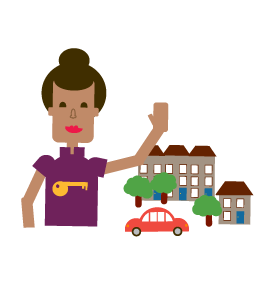- Staying well, connected to others and resilient
- New models of care and support with accommodation
KeyRing Creative approaches to supporting people in the community
Organisation
We offer many creative options to support people. Whatever support we are delivering, we start with the strengths and skills of the people we work with and the community they live in. KeyRing Networks are just one of the approaches we offer.
Our support is flexible, and so is our service design. We support local authorities to consider services that focus on their own challenges, embrace the strengths of the community and explore life beyond support.
What is the problem this Innovation solves?
Current models of support and care are expensive, do not lead to greater independence for the individual, there is a lack of flexibility and they struggle to become rooted in the local area. People find it hard to access ordinary housing, maintain social and community connections and live an ordinary life. People who would benefit from accessing preventative support, cannot do so until they are in a crisis situation. This means they take longer to get back on an even keel and their support costs significantly more for longer.
Solution
Each KeyRing Network consists of 9 -20 people living in their own homes, a volunteer lives in the neighbourhood, providing good neighbour support to the network members. By working with the network as a whole, KeyRing offers support that is flexible and personalised, mobilising peer, community, family and paid-for support. A network grows as people gain confidence and skills. Members who move on from formal support can continue to be involved in the social and mutual support aspects of the network, and access support to prevent crisis. Each Network is different and reflects the interests of its members.
Evidence base
Housing LIN’s Financial Case for KeyRing showed cashable savings of £187,168 per annum using the KeyRing model, with even greater long-term savings from preventative benefits; Emerging Horizons 2015 evaluation of the Recovery Network – people recovering from substance misuse formed a network; this stability meant more effective access to therapeutic and other services, with greatly improved abstinence rates; Hull University evaluation of Ancora project – current evaluation of 5 year ‘help through crisis’ partnership project.
Expected impact
A neighbourhood benefits from a KeyRing network by reducing loneliness and isolation, supporting community activity and engagement, maintaining tenancies, reducing anti-social behaviour, increasing income as people find work, access appropriate benefits, mobilising community action, increase in volunteering.
Reduced use of services, improved health and wellbeing, independence and active citizenship. Cost savings to local authority by ensuring ‘just enough support’.
Stage/spread (where it is/how much is there?)
Currently KeyRing is based in 34 local authorities, with 49 Networks in total, Oldham has 12 networks.
The impact of austerity on preventative services was severe, however we are now seeing a renewed focus on the preventative agenda in social care bringing a demand for effective, community empowerment models and leading to commissioning of new Networks.
What would councils/health organisations/local areas need to do or have in place to enable it to happen?
Outcome based commissioning, inlcuding Personal Budgets or ISFs – allowing provider to flex service up and down to respond to increasing and decreasing need; Place based co-produced commissioning; Trusting partnership with providers;Planned approach to re-provision of institutional/group support; Focus on neighbourhood support not social care groups
What would kill it?
Hours based commissioning; Intrusive regulation; Not recognising the value of the volunteer or the contribution of the network members;
A belief that KeyRing is low level support, whereas KeyRing is multi layered support.
Where to go for more information
www.keyring.org
claire.gleeson@keyring.org

